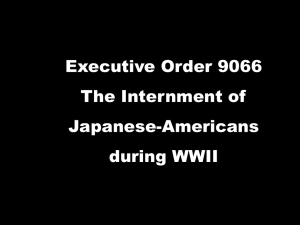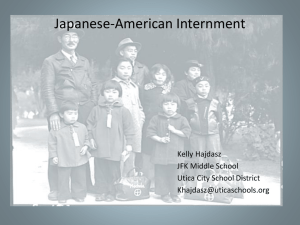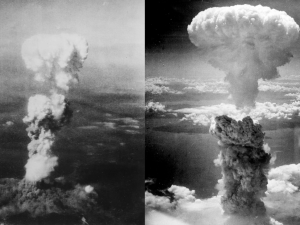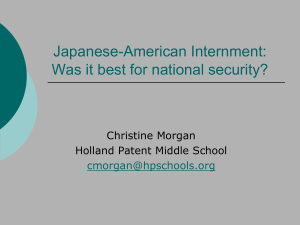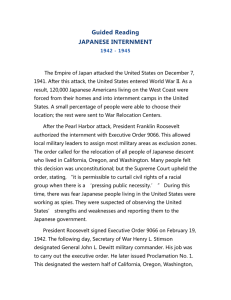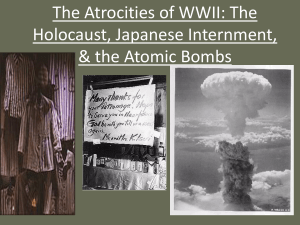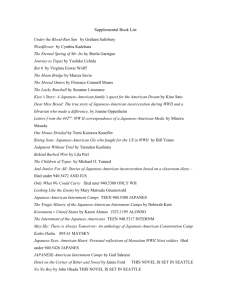Japanese Internment Facts
advertisement
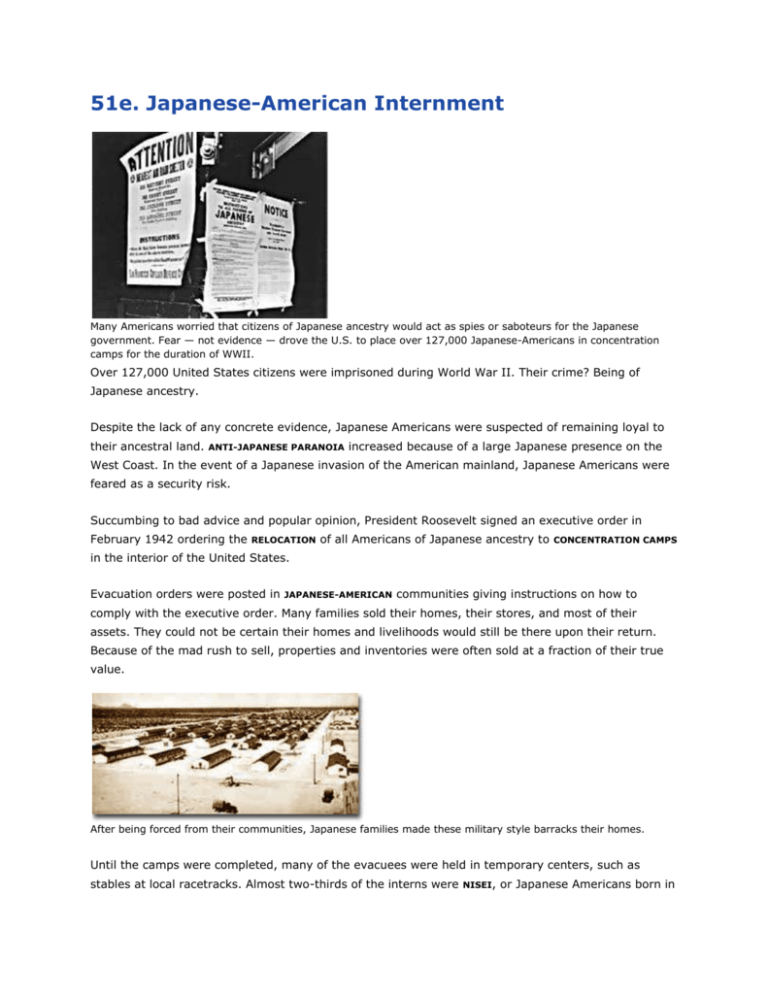
51e. Japanese-American Internment Many Americans worried that citizens of Japanese ancestry would act as spies or saboteurs for the Japanese government. Fear — not evidence — drove the U.S. to place over 127,000 Japanese-Americans in concentration camps for the duration of WWII. Over 127,000 United States citizens were imprisoned during World War II. Their crime? Being of Japanese ancestry. Despite the lack of any concrete evidence, Japanese Americans were suspected of remaining loyal to their ancestral land. ANTI-JAPANESE PARANOIA increased because of a large Japanese presence on the West Coast. In the event of a Japanese invasion of the American mainland, Japanese Americans were feared as a security risk. Succumbing to bad advice and popular opinion, President Roosevelt signed an executive order in February 1942 ordering the RELOCATION of all Americans of Japanese ancestry to CONCENTRATION CAMPS in the interior of the United States. Evacuation orders were posted in JAPANESE-AMERICAN communities giving instructions on how to comply with the executive order. Many families sold their homes, their stores, and most of their assets. They could not be certain their homes and livelihoods would still be there upon their return. Because of the mad rush to sell, properties and inventories were often sold at a fraction of their true value. After being forced from their communities, Japanese families made these military style barracks their homes. Until the camps were completed, many of the evacuees were held in temporary centers, such as stables at local racetracks. Almost two-thirds of the interns were NISEI, or Japanese Americans born in the United States. It made no difference that many had never even been to Japan. Even JapaneseAmerican veterans of World War I were forced to leave their homes. Ten camps were finally completed in remote areas of seven western states. Housing was spartan, consisting mainly of tarpaper barracks. Families dined together at communal mess halls, and children were expected to attend school. Adults had the option of working for a salary of $5 per day. The United States government hoped that the interns could make the camps self-sufficient by farming to produce food. But cultivation on arid soil was quite a challenge. Most of the ten relocation camps were built in arid and semi-arid areas where life would have been harsh under even ideal conditions. Evacuees elected representatives to meet with government officials to air grievances, often to little avail. Recreational activities were organized to pass the time. Some of the interns actually volunteered to fight in one of two all-Nisei army regiments and went on to distinguish themselves in battle. Fred Korematsu challenged the legality of Executive Order 9066 but the Supreme Court ruled the action was justified as a wartime necessity. It was not until 1988 that the U.S. government attempted to apologize to those who had been interned. On the whole, however, life in the relocation centers was not easy. The camps were often too cold in the winter and too hot in the summer. The food was mass produced army-style grub. And the interns knew that if they tried to flee, armed sentries who stood watch around the clock, would shoot them. FRED KOREMATSU decided to test the government relocation action in the courts. He found little sympathy there. In KOREMATSU VS. THE UNITED STATES, the Supreme Court justified the executive order as a wartime necessity. When the order was repealed, many found they could not return to their hometowns. Hostility against Japanese Americans remained high across the West Coast into the postwar years as many villages displayed signs demanding that the evacuees never return. As a result, the interns scattered across the country. In 1988, Congress attempted to apologize for the action by awarding each surviving intern $20,000. While the American concentration camps never reached the levels of Nazi death camps as far as atrocities are concerned, they remain a dark mark on the nation's record of respecting civil liberties and cultural differences. Suggest a Link The Japanese-American Internment Pre-war intelligence, domestic politics, internment camps and resistance are all featured at this megasite on the internment of Japanese-Americans during World War II. Don't miss the section "Memories" where you'll read personal accounts of those who were detained. Outstanding photo illustrations on each page, a comprehensive timeline, and a glossary which includes biographical information on key individuals. A top-notch resource. Report broken link Camp Harmony, Washington In the spring and summer of 1942, Seattle's Japanese-American community was forced to stay at nearby Camp Harmony, a temporary station before their removal to Tule Lake. This comprehensive, illustrated website doesn't neglect the facts, but its strength is in telling the human stories through such features as school, play, cycle of life, and letters to teachers and classmates back home. From the University of Washington. Report broken link Japanese-Americans Internment Camps of World War II After the bombing of Pearl Harbor, many thought the mainland was next. The United States, by order of the President, rounded up 120,000 people of Japanese ancestry for detention. The University of Utah provides these excellent photo galleries of life, work, and housing in the internment camps of Tule Lake, California, and Topaz, Utah. Click on the Tule and Topaz icons for stunning images of the bleak conditions endured by these people, many of whom were American citizens. Report broken link Department of Justice Compensation Announcement The Office of Redress Administration of the Department of Justice, outlines the specifics of the Civil Liberties Act of 1988, a law granting compensation for citizens who were detained during World War II. This site discloses the expenditures of the program and shows that many detainees were imported from other countries. Report broken link Heart Mountain Digital Preservation Project During World War II, The War Relocation Authority detained more than 14,000 Japanese Americans at the Heart Mountain Relocation Center in Wyoming. Click on "History" to gain a deeper understanding of the real reasons behind the internment of Japanese Americans, including the history of anti-Asian sentiment before the bombing of Pearl Harbor in 1941. You'll also get details on the entire history of Heart Mountain, including politics, economics, and living conditions. Report broken link War Relocation Authority Camps in Arizona We know we're punished — though we've committed no crime. These words were written by a Japanese American while detained in an Arizona internment camp during World War II. This site from the University of Arizona describes and shows vivid images of what life was like behind the wires for many thousands. Includes President Roosevelt's Executive Order #9066, which gave the military full control over thousands of Americans. Report broken link Japanese-American Incarceration Facts Researching the internment of Japanese-Americans during World War II? Visit here for raw facts from the Japanese-American National Museum. Includes the specific responsibilities of bureaucracies created by executive orders of President Roosevelt, related Supreme Court decisions, and a comprehensive list of internment camp locations and their dates of operation. Report broken link Evacuating Japanese-Americans Chronicling months of 1942 news articles from the San Francisco News, the Museum of the City of San Francisco presents the dramatic evacuation of the Japanese community. Spend some time here and you will get a real sense of the fear that gripped much of the country. Instructions to All Persons of Japanese Ancestry The full text of the military orders that forced the Japanese out of San Francisco. Report broken link I will start out my letter by writing about the worst thing. I do not want to go away but the government says we all have to go... -A junior high school Japanese-American student writes to his teacher as he leaves for an internment camp. Learn More... Report broken link You may think that the Constitution is your security — it is nothing but a piece of paper...it is nothing at all, unless you have sound and uncorrupted public opinion to give life to your Constitution... -Charles Evan Hughes, Chief Justice, US Supreme Court, 19301941 Learn More... Report broken link Latin American countries sent hundreds of citizens of Japanese ancestry to the U.S. during WWII to be held in internment camps. Learn More... Report broken link George Bush Apology How do you say you're sorry? President George Bush apologized on behalf of all Americans to the Japanese-Americans who were detained during World War II. Report broken link

